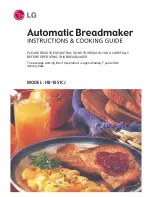
ICE TECH SS / SP Technical Service
Manual
27
PROBLEM
POSSIBLE CAUSES
SOLUTION
B) Low water pressure.
B) Increase water pressure if
possible. (This can often be done
by removing flowmeter on faucet).
C) Faulty fan or pressostat.
C) Check fan and re-adjust
pressostat or replace.
D) Inlet cooling water valve.
D) Check and replace (water-
cooled models only) if faulty.
E) Pressostat is faulty.
Adjust (40-43ºC), repair/replace
(w-cooled models).
F) Room or water temperature below
7ºC
F) Add one pin to each timer
wheel, in order to increas the
unstick time.
G) Faulty micro or timer.
G) Replace
H) Production cycle too long.
H) Adjust cycle thermostat to
increase the unsticking time.
I) Hot gas valve does not open.
I) Check valve.
6) Low ice production.
A) Blocked condenser or air access to
condenser.
A) Clean condenser; improve air
circulation by lifting machine from
floor and moving away from walls
and hot air sources .
B) In water-cooled machines:dirty
condenser,
badly
adjusted
valve,
pressostat, faulty water inlet valve or
faulty pressostatic valve.
B) Clean condenser; check,
adjust or replace.
C) Faulty hot gas valve, doesn’t close
totaly.
C) Replace.
D) Faulty fan or pressostat, faulty inlet
cooling water valve.
D) Check fan and re-adjust
pressostat or replace.
E) Refrigerant charge too high or too
low.
E) Adjust.
F) Faulty water inlet valve: leaks and
does not close fully.
F) Check and replace.
G) Inefficient compressor.
G) Replace.
7) Ice cube are so large that they stick A) Cycle thermostat is too low or faulty. A) Adjust or change.
together and form a SPab or plate of ice B) Timer wheels do not turn.
B) Tighten screws on timer.
(especially in very low ambient and
water
C) Timer motor is faulty.
C) Check and replace.
temperatures).
D) Micros on timer are faulty.
D) Replace, check for bridging.
8) Ice cubes are too large (especially in
low ambient and water temperatures).
A) Cycle thermostat is adjusted too
high.
A) Adjust until desired cube size.
9) Ice cubes are too small, and empty A) Cycle thermostat is adjusted too low. A) Adjust until desired cube size.
(especially in high ambient and water
temperatures).
B) Low refrigerant charge.
B) Add refrigerant until there is
frost formation 5 cm from the
compressor at the end of the
cycle.


































